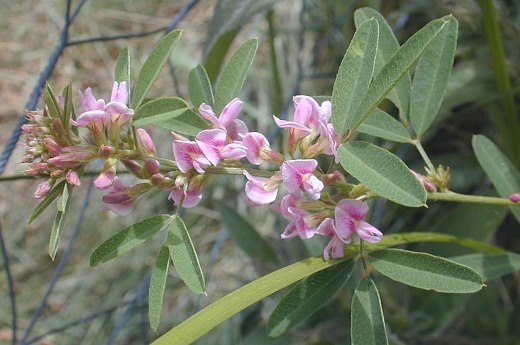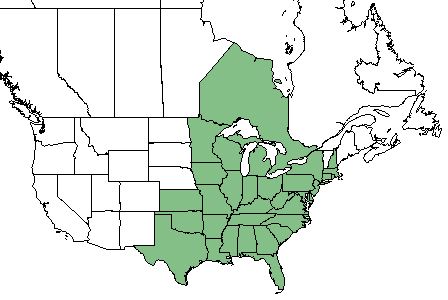Difference between revisions of "Lespedeza virginica"
| (3 intermediate revisions by the same user not shown) | |||
| Line 1: | Line 1: | ||
{{italic title}} | {{italic title}} | ||
| − | Common name: slender lespedeza<ref name= "USDA Plant Database"/> | + | Common name: slender lespedeza,<ref name= "USDA Plant Database"/> Virginia lespedeza, slender bush-clover<ref name=weakley>Weakley, A.S. 2020. Flora of the Southeastern United States. Edition of 20 October 2020. University of North Carolina at Chapel Hill, Chapel Hill, North Carolina.</ref> |
<!-- Get the taxonomy information from the NRCS Plants database --> | <!-- Get the taxonomy information from the NRCS Plants database --> | ||
{{taxobox | {{taxobox | ||
| Line 19: | Line 19: | ||
}} | }} | ||
==Taxonomic Notes== | ==Taxonomic Notes== | ||
| − | Synonyms: none | + | Synonyms: none<ref name=weakley/> |
| − | Varieties: none | + | Varieties: none<ref name=weakley/> |
==Description== | ==Description== | ||
| Line 28: | Line 28: | ||
==Distribution== | ==Distribution== | ||
| − | ''L. virginica'' ranges from Massachusetts, and New Hampshire, west to Michigan, Wisconsin, and Iowa, the south to Panhandle Florida and Texas. It also grows in the Ontario region of Canada.<ref name= "USDA Plant Database"/><ref name= | + | ''L. virginica'' ranges from Massachusetts, and New Hampshire, west to Michigan, Wisconsin, and Iowa, the south to Panhandle Florida and Texas. It also grows in the Ontario region of Canada.<ref name= "USDA Plant Database"/><ref name=weakley/> |
==Ecology== | ==Ecology== | ||
| Line 37: | Line 37: | ||
===Phenology=== <!--Timing off flowering, fruiting, seed dispersal, and environmental triggers. Cite PanFlora website if appropriate: http://www.gilnelson.com/PanFlora/ --> | ===Phenology=== <!--Timing off flowering, fruiting, seed dispersal, and environmental triggers. Cite PanFlora website if appropriate: http://www.gilnelson.com/PanFlora/ --> | ||
| − | ''L. virginica'' flowers from July to September and fruits from August to November.<ref name= | + | ''L. virginica'' flowers from July to September and fruits from August to November.<ref name=weakley/> |
===Seed dispersal=== | ===Seed dispersal=== | ||
Latest revision as of 15:14, 12 June 2023
Common name: slender lespedeza,[1] Virginia lespedeza, slender bush-clover[2]
| Lespedeza virginica | |
|---|---|

| |
| Photo by the Illinois Wildflowers Database | |
| Scientific classification | |
| Kingdom: | Plantae |
| Division: | Magnoliophyta - Flowering plants |
| Class: | Magnoliopsida - Dicots |
| Order: | Fabales |
| Family: | Fabaceae |
| Genus: | Lespedeza |
| Species: | L. virginica |
| Binomial name | |
| Lespedeza virginica L. | |

| |
| Natural range of Lespedeza virginica from USDA NRCS Plants Database. | |
Contents
Taxonomic Notes
Synonyms: none[2]
Varieties: none[2]
Description
L. virginica is a perennial forb/herb of the Fabaceae family native to North America and Canada.[1] It is an erect perennial that is 0.3-1 m tall. The stem is glabrate to moderately pubescent, mostly erect, can be ascending, and usually branched. Leavesare alternate, pinnately trifoliolate compound; leaflets 3, linear to narrowly oblong, without stipels. The leaflets are linear to narrowly oblong, 0.6-2.5 cm long, and 3-5 times long as wide. They are sparsely strigillose to glabrate above and densely strigillose beneath with narrowly linear stipules. Racemes are few-several flowered, axillary, and exceeded by leaves. Inflorescence peduncles and axes are densely strigillose with 0.5-1.2 mm long pedicels. Calyx is densely strigillose or puberulent with 1.2-2.4 mm long lobes. The petals are roseate to purplish and 5-7 mm long. l fruit is a 1-seeded, indehiscent pod. Legumes are broadly elliptic to ovate, 3-6 mm long, conspicuously reticulate, and sparsely strigillose.[3][4]
Distribution
L. virginica ranges from Massachusetts, and New Hampshire, west to Michigan, Wisconsin, and Iowa, the south to Panhandle Florida and Texas. It also grows in the Ontario region of Canada.[1][2]
Ecology
Habitat
L. virginica proliferates in sandhills, woodlands, and woodland borders.[5] Specimens have been collected from annually burned pineland, drying sandy loam of pine-oak woods, border of roadside and woodland, beech-magnolia forest, old field, old field with pine woods, open stand of shortleaf pine with snady clay, young slash pine plantation, disturbed regions such as roadsides and fields, and longleaf pine wiregrass ridge.[6]
L. virginica had variable changes in occurrence and abundance in response to clearcutting and chopping in South Carolina. It has shown either regrowth or been unaffected in reestablished habitats that were disturbed by clearcutting and chopping.[7]
Phenology
L. virginica flowers from July to September and fruits from August to November.[2]
Seed dispersal
This species is thought to be dispersed by gravity.[8]
Fire ecology
L. virginica increases in abundance with increasing fire frequency.[9] Populations have been known to persist through repeated annual burns.[10][11] \
Conservation, cultivation, and restoration
L. virginica is listed as threatened by the New Hampshire Natural Heritage Inventory Division of Land and Forests and by the Wisconsin Department of Natural Resources Bureau of Endangered Resources.[1]
Cultural use
Photo Gallery
References and notes
- ↑ 1.0 1.1 1.2 1.3 USDA Plant Database https://plants.usda.gov/core/profile?symbol=LEVI7
- ↑ 2.0 2.1 2.2 2.3 2.4 Weakley, A.S. 2020. Flora of the Southeastern United States. Edition of 20 October 2020. University of North Carolina at Chapel Hill, Chapel Hill, North Carolina.
- ↑ Radford, A. E., Ahles, H. E., & Bell, C. R. (1968). Manual of the vascular flora of the Carolinas. Chapel Hill: University of North Carolina Press.
- ↑ Gee, K. L., et al. (1994). White-tailed deer: their foods and management in the cross timbers. Ardmore, OK, Samuel Roberts Noble Foundation.
- ↑ Weakley, A. S. (2015). Flora of the Southern and Mid-Atlantic States. Chapel Hill, NC, University of North Carolina Herbarium.
- ↑ URL: http://herbarium.bio.fsu.edu. Last accessed: June 2018. Collectors: A.F. Clewell, Loran C. Anderson, Gary Knight, R. Kral, R.K. Godfrey, Richard S. Mitchell, R. Komarek, Norman E. Hill, Delzie Demaree, D.S. Correll. States and counties: Florida (Leon, jackson, washington, Holmes, Okaloosa, jefferson, Madison, Liberty) Goergia (Thomas, Grady, Haralson, Marion, Chattooga, Coweta, Talbot, Meriwether, Webster, Lee, Miller, Crisp, Appling, Wheeler, Wilcox, Dodge, Walker, Clarke, Long, De Kalb, Heard, Randolph, Clay, Decatur, Steart, Muscogee, Troup, Chattahoochee, Walker, Baker, Harris)
- ↑ Cushwa, C.T. and M.B. Jones. (1969). Wildlife Food Plants on Chopped Areas in Piedmont South Carolina. Note SE-119. Asheville, NC: U.S. Department of Agriculture, Forest Service, Southeastern Forest Experiment Station. 4 pp.
- ↑ Kirkman, L. Katherine. Unpublished database of seed dispersal mode of plants found in Coastal Plain longleaf pine-grasslands of the Jones Ecological Research Center, Georgia.
- ↑ Burton, J. A. (2009). Fire frequency effects on vegetation of an upland old growth forest in eastern Oklahoma. Environmental Science. Stillwater, Oklahoma, Oklahoma State University. Bachelor: 78.
- ↑ Robertson, K.M. Unpublished data collected from Pebble Hill Fire Plots, Pebble Hill Plantation, Thomasville, Georgia.
- ↑ Glitzenstein, J. S., D. R. Streng, R. E. Masters, K. M. Robertson and S. M. Hermann 2012. Fire-frequency effects on vegetation in north Florida pinelands: Another look at the long-term Stoddard Fire Research Plots at Tall Timbers Research Station. Forest Ecology and Management 264: 197-209.